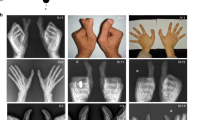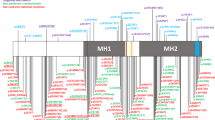Abstract
Anonychia and hyponychia congenita (OMIM 206800) are rare autosomal recessive conditions in which the only presenting phenotype is the absence or severe hypoplasia of all fingernails and toenails. After determining linkage to chromosome 20p13, we identified homozygous or compound heterozygous mutations in the gene encoding R-spondin 4 (RSPO4), a secreted protein implicated in Wnt signaling, in eight affected families. Rspo4 expression was specifically localized to developing mouse nail mesenchyme at embryonic day 15.5, suggesting a crucial role in nail morphogenesis.
NOTE: In the version of this article initially published, the national origin of the three consanguineous families (P2–P4) was incorrectly described as Indian. The national origin of all three families (P2–P4) is Pakistani. This error has been corrected in the HTML and PDF versions of the article.
This is a preview of subscription content, access via your institution
Access options
Subscribe to this journal
Receive 12 print issues and online access
$209.00 per year
only $17.42 per issue
Buy this article
- Purchase on Springer Link
- Instant access to full article PDF
Prices may be subject to local taxes which are calculated during checkout


Similar content being viewed by others
Change history
27 November 2006
In the version of this article initially published, the national origin of the three consanguineous families (P2–P4) was incorrectly described as Indian. The national origin of all three families (P2–P4) is Pakistani. This error has been corrected in the HTML and PDF versions of the article.
References
Dawber, R., de Berker, D. & Baran, R. in Diseases of the Nails and Their Management (Blackwell Science, Oxford, 2001).
Chuong, C.M., Widelitz, R.B., Ting-Berreth, S. & Jiang, T.X. J. Invest. Dermatol. 107, 639–646 (1996).
Dreyer, S.D. et al. Nat. Genet. 19, 47–50 (1998).
Chen, H. et al. Nat. Genet. 19, 51–55 (1998).
Jumlongras, D. et al. Am. J. Hum. Genet. 69, 67–74 (2001).
Loomis, C.A. et al. Nature 382, 360–363 (1996).
Hopsu-Havu, V.K. & Jansen, C.T. Arch. Dermatol. 107, 752–753 (1973).
Garshasbi, M. et al. Hum. Genet. 118, 708–715 (2006).
Gudbjartsson, D.F., Jonasson, K., Frigge, M.L. & Kong, A. Nat. Genet. 25, 12–13 (2000).
Kamata, T. et al. Biochim. Biophys. Acta 1676, 51–62 (2004).
Nam, J.S., Turcotte, T.J., Smith, P.F., Choi, S. & Yoon, J.K. J. Biol. Chem. 281, 13247–13257 (2006).
Kim, K.A. et al. Cell Cycle 5, 23–26 (2006).
Kazanskaya, O. et al. Dev. Cell 7, 525–534 (2004).
Wilkinson, D.G. In Situ Hybridization: a Practical Approach. (Oxford Univ. Press, New York, 1992).
Acknowledgements
We thank the family members for their participation in this study, and we would like to acknowledge the assistance of K. Fantauzzo and H. Bazzi from the Department of Genetics and Development, Columbia University. This work was partially supported by the Association for International Cancer Research (D.P.K.), the German Federal Ministry of Science and Education through the National Genome Research Network (F.R.), the Ministry of Education, Culture, Sports, Science and Technology in Japan (Y.I.) and the National Institutes of Health/US Public Health Service grant R01AR44924 (A.M.C.).
Author information
Authors and Affiliations
Contributions
The molecular study was designed and supervised by D.P.K. and A.M.C. The clinical study was designed and supervised by E.A.O.T. Laboratory work was performed by D.C.B., Y.I., H.C.U., M.-T.T. and C.S.; statistical analysis was performed by F.R.; clinical contributions were made by V.K.H., N.T., C.M., R.W., D.d.B. and M.W. D.C.B., Y.I., E.A.O.T., F.R., A.M.C. and D.P.K. all contributed to the writing of the manuscript.
Corresponding author
Ethics declarations
Competing interests
The authors declare no competing financial interests.
Supplementary information
Supplementary Fig. 1
Two pedigrees (P1 and F) with genotypes of microsatellite/SNPs mapping to 20p13. (PDF 103 kb)
Supplementary Fig. 2
Pedigree P2 with genotype data. (PDF 168 kb)
Supplementary Fig. 3
Haplotypes of family P2 and schematic showing minimal region harboring the anonychia gene. (PDF 108 kb)
Supplementary Fig. 4
Examples of two mutations detected in the anonychia families. (PDF 54 kb)
Supplementary Table 1
Primers for additional microsatellite markers between D20S117 and D20S906 and for mutation analysis of genes in the candidate region. (PDF 124 kb)
Rights and permissions
About this article
Cite this article
Blaydon, D., Ishii, Y., O'Toole, E. et al. The gene encoding R-spondin 4 (RSPO4), a secreted protein implicated in Wnt signaling, is mutated in inherited anonychia. Nat Genet 38, 1245–1247 (2006). https://doi.org/10.1038/ng1883
Received:
Accepted:
Published:
Issue Date:
DOI: https://doi.org/10.1038/ng1883
This article is cited by
-
Current Trends in the Treatment of Traumatic Nail Injuries and the Prospect of Solutions from Regenerative Engineering
Regenerative Engineering and Translational Medicine (2023)
-
Single-cell RNA sequencing of human nail unit defines RSPO4 onychofibroblasts and SPINK6 nail epithelium
Communications Biology (2021)
-
The role of R-spondin proteins in cancer biology
Oncogene (2021)
-
Production, purification and characterization of recombinant human R-spondin1 (RSPO1) protein stably expressed in human HEK293 cells
BMC Biotechnology (2020)
-
Combined approach for finding susceptibility genes in DISH/chondrocalcinosis families: whole-genome-wide linkage and IBS/IBD studies
Human Genome Variation (2017)



